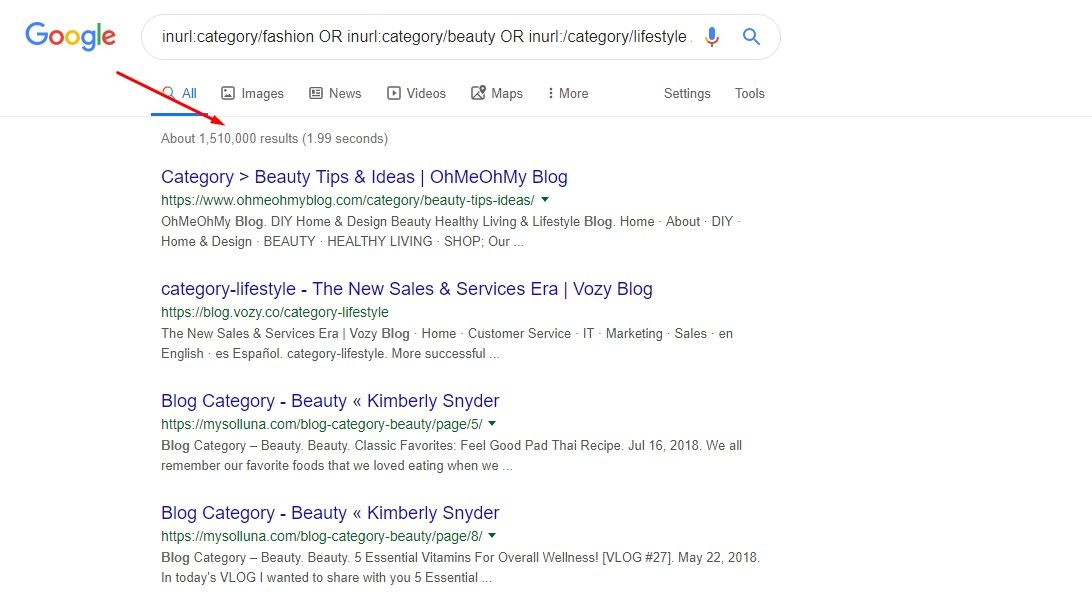Fashion, beauty and lifestyle niches have turned into rather oversaturated online markets, so in order for
your client to stand out from the crowd, they need to provide their audiences with unique content and a
different approach to the services/products they offer. And to do that, you need a firm grasp on:
- What your client currently has to offer in terms of linkable assets
- What their preferred tone of voice is
- What their goals and values are, etc
This type of research includes:
-
Detailed Content Audit - Go through your client’s current content and see which posts
need revising, improving, expanding, updating and promoting, but also determine if there are any posts
that need to be completely removed.
-
Determining Your Client’s Goals - Discuss your client’s overarching goals so you can
come up with the most appropriate keyword implementation strategy, and ask them to provide you with a list
of competitors that have a strong online presence and to whom they look up to the most in terms of
standards.
-
Your Client’s Investment Scope - Without any beating around the bush, discuss which SEO
tactics they are able and willing to invest in. This is a crucial step as it will help you frame your
entire link building strategy for that specific client.
-
Additional Assets - Ask your client about potentially valuable assets other than their
content and website. For example, strong industry connections whose audiences you can attract, valuable
partners who can help you boost your client’s online presence, etc.
Competitor research
Thorough
analysis of your client’s direct competitors
will give you a valuable insight into which link building goals you are likely to achieve, but just as
importantly, which ones are not worth chasing after. Not only will this research provide you with numerous
prospects right away, it will help you find data critical to forming the rest of your off-site strategy.
Main aspects of quality competitor analysis include:
-
Backlinks
Have one column in your table filled with websites linking to your client’s competitors and, while
you’re in this phase, make notes on the best way to contact each of them. Example: Let’s say the page
you are writing down is a lifestyle blog. It is recommended that you save the contact email address of
that particular blogger, but also make sure you save their “write for us” page (should they have one,
that is).
Advanced Tip:
If you notice any broken links on their pages, write them down in your spreadsheet as well. We’ll
explain why this may be crucial later in this post.
-
Keywords and Anchors Closely examining competitors’ keywords and both incoming link anchors and
internal link anchors, can be paramount to coming up with your own strategy. Take note of how most
successful links are anchored, but be sure to process less successful ones too. As far as keywords are
concerned, pay close attention to those you want to rank for, as well as the ones that may come in handy
later on.
Useful Tip:
When it comes to fashion, beauty and lifestyle niches, incorporating names of prominent
influencers/niche-oriented brands/industry events as keywords can really make a difference.
-
Content Much like you would analyze the
quality of your client’s content, you should thoroughly examine the content their direct competitors are posting. Take note of blog
posts that have generated most engagements in terms of shares, likes, comments, organic traffic, average
time on page, organic backlinks, etc...
Think about what makes this content successful:
- Is it substance?
- Tone of voice?
- The promotional strategy around it?
- All of the above?
Step 3: target audience research
Defining the general ideal target audience persona for the fashion, beauty and lifestyle markets is not
too difficult, but learning specifics about them and leveraging that data to your advantage can make or
break your SEO strategy.
Some useful questions include:
- What type of content do they enjoy reading the most?
- What tone of voice do they like? Why?
- Which social media platforms are their main hubs? (so you know where to reach them)
-
How do they perform their searches? In what way in particular do they
formulate the queries
related to fashion/lifestyle/beauty?
- Who are the most trusted influencers? Why do they find them remarkable?
Advanced Tip:
Use Google Analytics to record the behavior of the client's target audience; Search forums and social
media for useful comments; Read related blogs; Check out the most popular YouTupe channels; etc.
Link building tactics for fashion, beauty and lifestyle websites
If you have been paying attention while going through the backlinks of your competitors, you have noticed a
number of patterns. Apart from perhaps identifying
tactics that you might want to try yourself, chances are you have also noticed recurring footprints in the URL, titles or content of pages you were
coming across.
Now it’s time to put that research to good use and decide which of the link building approaches are most
suitable for your client. To get you started, here are some of the most effective tactics in these
industries.
Guest posting on fashion, beauty and lifestyle blogs
Writing guest posts for established private or commercially-owned blogs is a popular link building tactic,
not just in this industry, but pretty much across all of them. This makes it a perfect example to illustrate
how you should
compose your queries in Dibz in order to
find these, or any other type of prospects. Naturally, these queries will work in Google as well, and there
are other ways to find these blogs, like checking the comments of the ones you did find or seeing where else
those guest posting on one site also contributed an article.
So, what do you need to do to
find all the fashion, beauty and lifestyle blogs that you might need?
There are three basic approaches:
-
Looking for blogs with ‘write for us’ pages: These sites are low-hanging fruit, which means
everyone gets to them sooner or later. That’s not to say that you can get a link from just any of them,
as there are quite a few respectable publications out there with some kind of ‘submission guidelines’ or
‘write for us’ pages. However, if you put in the required effort, at least you know that sites found
this way will be willing to read through your pitch and judge it on its merits. The parameters you need
to use for this search are mostly different variations of the same idea.
Parameters:
- inurl:/add/post
- inurl:/article-submission-information/
- inurl:/article-submission/
- inurl:/become-a-guest-blogger
- inurl:/become-a-guest-writer/
- inurl:/write-for
- intitle:”submission guidelines”
- intext:"your post must be original"
Advanced Tip:
You don’t have to use only one parameter (or a keyword) in a query, but can include several different
variants of it by tying them together with OR advanced operator. intitle:“submit an article” OR
intitle:“contribute to our site” OR intitle:“guest post guidelines”.
Naturally, you need to make sure that the keywords you will use are the ones that blogs you are
looking for often use on their ‘write for us’ pages. This usually includes broader categories related
to fashion, beauty and lifestyle; anything you’d find in the title of a post suitable for the blog;
phrases describing the audience likely to read the blog, etc. You can, and probably should, start
going through ‘write for us’ pages of sites that you already know about, and creating a list of the
most common phrases found there, but to get you started, here are some of them.
Keywords
- beauty routine
- fashion industry
- cosmetic procedures in 2019
- spring makeup trends
- fitness boot camp
- lifestyle
- women’s walking shoes
- fashion statement
- bridesmaid dresses
- jewellery tips
- engagement ring trends
- beach outfits
- infinity dress
- hottest look
- kid’s fashion trends
- apply self-tanner
- fall fashion trends
- boho look
- vintage jewelry
- fashion boutique
- styling tips
- gift ideas
- fashion advice
- lip arts
- naturally healthy skin
- outdoor wedding
- shabby chic decor
- high fashion
- sense of style
- pashmina scarf
- oil-based exfoliators
Advanced Tip:
The fewer possible meanings and different interpretations a word or a phrase has, the better it’s
suited for this kind of research. For instance, the word ‘exfoliators’ can mean only one thing and
would do a fine job of defining the niche you are interested in on its own.
-
Looking for blogs that already have published guest posts Blogs that are open to
publishing guest posts don’t necessarily have to have a ‘write for us’ page, they just need to be, well,
publishing guest posts. Since you are looking for pages with the posts themselves, aside from the
keywords we already listed, you can also use the names of popular brands or prolific guest authors,
popular procedures unique to the niche, etc. Now you just need to explain which pages you are looking
for. Here are several ways to do so.
Parameters
- guest AND post OR article OR contribution OR journal
- “guest contributor” OR “guest blogger” OR “contributing writer”
-
“community post, written by one of our” OR “guest post was written by” OR “guest post courtesy of”
-
Looking for fashion, beauty and lifestyle blogs in general: The previous two methods may lead to
blogs which are likely to accept your contribution proposal, but they leave a lot of room for otherwise
amazing blogs to slip by. In other words, with this method, your response rates may be lower, but you’ll
leave no stone unturned. Any of the keywords we mentioned so far should do just fine in this search, and
since the only task that the parameter has is to explain that it’s a blog that you are looking for, you
have all the freedom to experiment with different combinations.
Parameters
- inurl:/2021/ AND inurl:/blog/
- intext:blogroll OR intext:roundup
- inurl:about AND intext:”this blog is meant” OR intext:“we write about”
-
inurl:category/fashion OR inurl:category/beauty OR inurl:/category/lifestyle AND intext:blog OR
intitle:blog
Advanced Tip:
You may have noticed that the last parameter is enough on its own to bring you a ton of relevant
results. In cases like this, you can use the Keywords box in Dibz to provide even more detail about
the kind of blog you are looking for.
Influencer outreach
Fashion, beauty and lifestyle are niches where it’s more who you know than what you know. Influencers play a
huge role in getting the word about you out, presenting you to a narrowly defined audience in the most
appropriate light; and of course, leading you to other influencers or linking prospects in general. If you
are interested in promoting a fashion, beauty or lifestyle site with the help of relevant influencers, we
have a detailed
Influencer Marketing Guide, but just to get you started, here’s where to look for them.
Their blog - Even if you never prospected specifically for blogs, you had to have come across quite a few of
them during the competitor analysis. Just form one relevant blog you can get:
- The influencers contact info, including social network profiles
- Perhaps a number of other influencers associated with the blog, or outside contributors
- Other similar blogs, by examining the blogroll
- Other similar blogs, by doing a backlink check
- Other similar blogs, by checking the comments on posts
You could repeat this process indefinitely, but you can also use the tips we provided in the Guest posting
section of this post, and simply get
Dibz to find these influencers and their blogs.
Social networks - you could also start with a single influencer and then branch out your search from them,
but there are more efficient ways to scan the social networks for people of adequate profile. From joining
relevant groups on Facebook to searching Twitter for relevant hashtags; the greater challenge in this kind
of prospecting is to keep everything tidy than to actually find prospects. For instance, Google gives you a
great way to search social network websites for any kind of influencer you might need. For instance, the
search below will lead you to profiles with anything between 1 and 1000 posts and anything between 1000 and
5000 followers. Simply add the keywords you need to define the subject matter likely to be found on these
profile pages, and you’re all set.
"1..1000 posts 1000..5000 followers" site:instagram.com
You can do the same with YouTube, Pinterest or other sites likely to be interesting to fashion, beauty and
lifestyle influencers, you just have to identify the footprints that these sites use, and find a way to
express them through adequate queries.
Brand mentions
If your client is at least a somewhat established brand name in the industry, or if they are associated with
a popular and often quoted influencer, you can get an impressive amount of links just by checking for
unlinked mentions of the brand or influencer. The reason this method is so effective is that you don’t need
a lot of time to find the sites mentioning you, don’t need to prepare any resources or even compose a
particularly well-drafted email, since people mentioning you often feel almost obliged to add the proper
attribution when asked. There are a number of ways to find these sites, from Googling all the mentions of
your brand and either comparing that list with your entire backlink portfolio, or running it through
Screaming Forg’s SEO Spider with an adequate filter (containing your bare domain - example.com) to check
which of them are linking to you; to simply using
Ahrefs Content Explorer. Once you
have a list of websites that are discussing your client but not linking to them, all you need to do is
evaluate which of them are relevant and decent enough for you to actually want a link there, and move on
straight to outreach.
Giveaways and reviews
While this tactic has often been abused to the point where it
crosses over into black-hat, if you do it right, it won’t only bring you links and brand recognition, but might actually do wonders
for your credibility. While there are bloggers who will write praises about each and every product they have
been sent for review, you don’t really need that kind of promotion. Naturally, you also want to stay away
from the ones who have never said anything nice about anything, and instead look for those who seem to be
the most objective and honest. While they might say less than ideal things about your product, they have the
trust of their audience, and their sites are likely to have much more to offer to you, both in terms of
metrics and in terms of targeted exposure. You have probably seen quite a few of these websites when
exploring your niche competitors. Like you would for other tactics, examine those sites for convenient
footprints and start looking for your own review or giveaway websites.
exfoliator inurl:product-review
hair straightener intitle:product AND intitle:review
eyeliner inurl:giveaway
Advanced Tip:
Some of the results you’ll get with these searches won’t be sites accepting giveaways, but those offering
them. Simply get the backlinks of pages they are promoting (or the entire domain), and you should end up
with a nice list of prospects
Outreach
The part that everything so far has been building up to. You’ve done your research, made lists upon lists
of prospects, and now it’s time to actually turn all of that information into links. However, this is also
where the problems start. Up until now, everything was strictly under your control, but at this point, you
have to give the reins to someone else, i.e the person you are contacting. Since it’s very depressing to
see how the effort you’ve invested so far can go to waste simply because of someone’s disinterest in
opening your email, or their unwillingness to reply to it; we asked our link builders what do they believe
are best practices when it comes to negotiating fashion, beauty and lifestyle backlinks. Here’s a summary
of their suggestions (focused on outreach for guest posting, but mostly applicable to other tactics as
well), followed by a
template email example.
Email subject line
Even though getting a negative answer is by no means pleasant, it might even be worse to realize that your
email has never even been opened. Getting the person you’re contacting to at least take a look at your offer
is absolutely critical, which is why you need to keep
experimenting with your subject lines
until you find a pattern that people seem to be responding to. According to our link builders, subject lines
shouldn’t be too long, and they seem to perform better when you include the name of the blogger you are
contacting or their blog. Some bloggers won’t mind you using phrases like ‘guest post’ in your subject line
(some even demand it in their submission guidelines), but others may associate it with spam immediately and
respond much better to usual euphemisms like ‘collaboration inquiry’ or something along those lines.
Email body
If you got your contact to this point, congratulations! So, what now? First you need to introduce yourself
while unobtrusively explaining why you would make a perfect contributor to their blog. You can do this by
listing the sites you’ve already had your articles published on (possibly by just giving them a link to your
online portfolio, to keep the email cleaner); providing an insightful comment on one of their posts; or
discussing a trending issue, but what you say isn’t the only thing that will leave an impression, you also
have to pay close attention to how you’ll say it. Fashion, beauty and lifestyle bloggers usually have very
high aesthetic standards, and how your email is formatted and presented gives them a clue regarding what
your post might look like if they agree to publish it. So, even if you don’t have to be overly formal and
careful when it comes to the tone and register you’ll use (it’s often better if you are not, as a matter of
fact), you do when it comes to the layout and formatting of your email.
Topics to offer
If you’ve done everything else right, the thing that will decide if your proposition is going to be accepted
or not, is the
topic that you are going to suggest
you cover. Naturally, some bloggers prefer giving you the topics themselves, but it is usually recommended
that you approach them with a couple of already formulated ideas.
Aside, of course, from making sure that you don’t offer a topic that they have already covered, you also
have to make sure that they’ll find it interesting and suitable for their blog. So, if you see that most of
their posts are about generic trending topics, that’s what you’ll offer, regardless of what may be your
first instinct. If a blog that you’re contacting is good enough to justify you putting in a bit of extra
effort, you might even want to find its editor on social networks, and see what kind of posts they usually
enjoy and share.
Follow-up
If you get absolutely no response to an email, you shouldn’t give up on it just yet. The more popular the
site you’re contacting the busier its editors will be. Sometimes they simply won’t get around to opening
your email; or they may open it, decide to answer later and then simply forget about it. This is why you
should always follow up unanswered emails with at least two polite reminders, and definitely not more than
four. There should be at least a couple of days before your follow-ups, and of course, if someone gets tired
of your emails and asks you to stop, apologize nicely and remove them from your outreach list.
Mail template
Hello [blogger’s name],
I hope your day is going great :) I enjoyed reading [one of their articles] recently and it inspired me to
get in touch.
My name is [name], a lifestyle consultant by day and a beauty blogger by night. I have always been
creatively inclined and design plays a huge role in my personal expression. Over the years I also wrote
pieces for [established relevant publication].
If you wish to check the quality of my writing in more detail, you can take a look at my online portfolio
here: [link to portfolio]
I was wondering if you would be interested in having me write a guest piece for you? I'm on the constant
lookout for new writing challenges and would love an opportunity to write for your beautiful blog :) It goes
without saying that I would promote the article through my social profiles, so you’d get additional traffic.
Does this sound like something you’d be interested in? Please let me know what you think so we can talk
about the next steps. I appreciate your time, and am really looking forward to working together :)
Kindest regards, [name]
Closing words
In the attempt to present every aspect of fashion, beauty and lifestyle link building, we didn’t have the
time to get into too much detail regarding how you should
evaluate the sites you come across
or how to
assess the value of a particular link. Luckily, our site is full of related resources you can use to polish your strategy to perfection. The
point of this post was to give you a solid jumping off point and a framework for what the entire process
looks like, for particulars on any other aspect of link building, you can visit our
Learn SEO section.

 We fixed link building
We fixed link building We fixed link building
We fixed link building We fixed link building
We fixed link building We fixed link building
We fixed link building Use cases
Use cases Outreach
Outreach Buying links
Buying links Selling links
Selling links Features
Features Backlinks Health Check
Backlinks Health Check Link Building API
Link Building API Blacklisted Links
Blacklisted Links Easily Sell Links
Easily Sell Links SEO Metrics by Ahrefs
SEO Metrics by Ahrefs Chrome extension
Chrome extension Link Building Database
Link Building Database Team Management Tool
Team Management Tool SEO Reporting Dashboard
SEO Reporting Dashboard Index Your Backlinks
Index Your Backlinks LB Outreach Management
LB Outreach Management Expiring Links Alerts
Expiring Links Alerts Automatic SPAM Analysis
Automatic SPAM Analysis Link Building Transparency
Link Building Transparency Google Link Index Checker
Google Link Index Checker Manage External Link Builders
Manage External Link Builders
